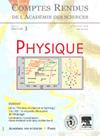有机玻璃形成液体和易碎性的概念
IF 1.2
4区 物理与天体物理
Q3 ASTRONOMY & ASTROPHYSICS
引用次数: 0
摘要
玻璃成型材料的一个重要类别是有机材料;它包括分子液体,聚合物,溶液,蛋白质,可以通过在标准条件下冷却液体或经过特殊热处理而玻璃化。应用范围很广,从材料到生命科学,最近又到电子学。为了将它们与本刊中描述的其他体系区分开来,本文介绍了一些具体的性质,如玻璃化转变温度(tg)的范围、玻璃化的能力以及确定tg位置的一些经验法则。这些液体最显著的特性是,当温度接近tg时,它们的粘度或结构松弛时间增加得有多快。为了描述这种行为并对不同强度的液体进行排序,C.A.安吉尔在近40年前引入了脆弱性的概念。他建议用T - g标度法在阿伦尼乌斯图中将液体分为易碎和坚固两类(除了在特定条件下的水外,在有机玻璃中从未观察到最强的液体)。施加压力可以改变给定液体的T g值和脆性指数,即改变密度。然后可以在P-T相图中探索过冷/过压缩液体和玻璃的性质。T - g线对应于一条等时线,即不同密度-温度对在恒定松弛时间下的一条线。我们观察到,所有数据都可以放置在仅依赖于单一密度和物种相关且与t无关的有效相互作用能E∞(ρ)的主曲线上。等时脆性指数被定义为一种给定液体的固有特性,它可以帮助理顺T g以下的玻璃特性与T g以上的粘性减速之间的所有相关性。液体的几何约束也是一种改变液体动力学和玻璃性质的方法;它与自然界中遇到的大量情况相对应。另一个相图T-d(定义孔径的d)可以定义为玻璃化转变的孔径依赖关系,这也受到表面相互作用的强烈影响。本文章由计算机程序翻译,如有差异,请以英文原文为准。
Organic Glass-Forming Liquids and the Concept of Fragility
An important category of glass-forming materials is organic; it includes molecular liquids, polymers, solutions, proteins that can be vitrified by cooling the liquid under standard conditions or after special thermal treatments. The range of applications is large from materials to life sciences and recently to electronics. To distinguish them from other systems described in this issue, some specific properties such as the range of their glass transition temperature (T g ), their ability to vitrify and some rules of thumb to locate T g are presented. The most remarkable property of these liquids is how fast in temperature their viscosity or structural relaxation time increases as approaching T g . To characterize this behavior and rank the liquids of different strength, C.A. Angell introduced the concept of Fragility nearly 40 years ago. He proposed to classify liquids as fragile or strong in an Arrhenius plot with T g scaling (the strongest ones have never being observed in organic glasses, except for water under specific conditions). The T g value and the fragility index of a given liquid can be changed by applying pressure, i.e. changing the density. One can then explore the properties of the supercooled/overcompressed liquid and the glass in a P-T phase diagram. The T g line corresponds to an isochronic line, i.e. a line at constant relaxation time for different pairs of density-temperature. We observe that all data can be placed on master-curves that depend only on a single density- and species-dependent and T-independent effective interaction energy, E ∞ (ρ). An isochoric fragility index is defined as an intrinsic property of a given liquid, that can help in rationalizing all the correlations between the glass properties below T g and the viscous slowing down just above T g from which they are made. Geometrical confinement of liquids is also a way to modify the dynamics of a liquid and the properties of a glass; it corresponds to a large number of situations encountered in nature. Another phase diagram T-d (d defining pore size) can be defined with a non-trivial pore size dependence of the glass transition, which is also strongly affected by surface interactions.
求助全文
通过发布文献求助,成功后即可免费获取论文全文。
去求助
来源期刊

Comptes Rendus Physique
物理-天文与天体物理
CiteScore
2.80
自引率
0.00%
发文量
13
审稿时长
17.2 weeks
期刊介绍:
The Comptes Rendus - Physique are an open acess and peer-reviewed electronic scientific journal publishing original research article. It is one of seven journals published by the Académie des sciences.
Its objective is to enable researchers to quickly share their work with the international scientific community.
The Comptes Rendus - Physique also publish journal articles, thematic issues and articles on the history of the Académie des sciences and its current scientific activity.
From 2020 onwards, the journal''s policy is based on a diamond open access model: no fees are charged to authors to publish or to readers to access articles. Thus, articles are accessible immediately, free of charge and permanently after publication.
The Comptes Rendus - Physique (8 issues per year) cover all fields of physics and astrophysics and propose dossiers. Thanks to this formula, readers of physics and astrophysics will find, in each issue, the presentation of a subject in particularly rapid development. The authors are chosen from among the most active researchers in the field and each file is coordinated by a guest editor, ensuring that the most recent and significant results are taken into account. In order to preserve the historical purpose of the Comptes Rendus, these issues also leave room for the usual notes and clarifications. The articles are written mainly in English.
 求助内容:
求助内容: 应助结果提醒方式:
应助结果提醒方式:


